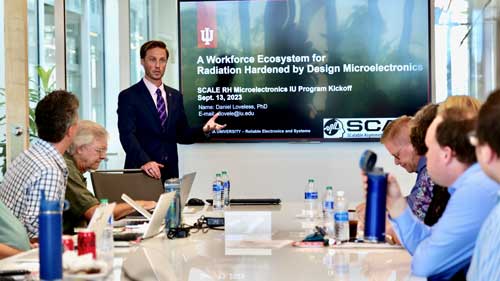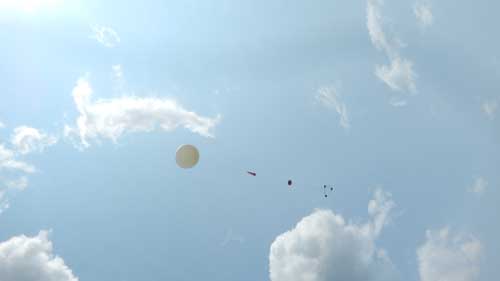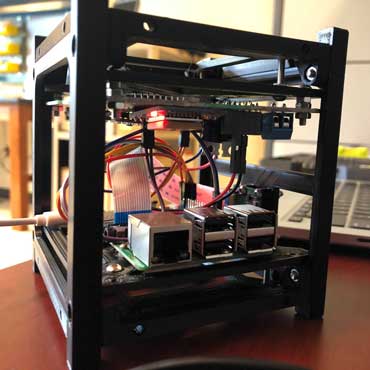World-changing opportunity finds Daniel Loveless in a fourth-floor Luddy School office, a solar-powered, blue-green desk globe (a gift from a former student) spinning non-stop beside the newly hired associate professor of intelligent systems engineering, optimism evident in every word.

“We have some fun initiatives and exciting missions,” Loveless says.
That includes break-through technology; restoring the United States to microelectronic dominance; great-paying jobs in the space and defense industries; cutting-edge instruction to supply the people needed to fill those jobs; and dynamic research that includes cyclotrons and sub-orbital balloons as students build and test microelectronics in extreme environments.
It’s all there for the taking, and Loveless is helping the Luddy School of Informatics, Computing and Engineering lead the way.
It’s only the beginning.
“The number of opportunities is far more than the number of students we have,” Loveless says.
That will change as part of a new Luddy School initiative, “A Workforce Ecosystem for Radiation Hardening by Design,” that prioritizes student talent development in Indiana and the Ohio River Valley. It’s supported by a $5 million grant from NSWC Crane and $1 million from the Indiana Economic Development Corp.
The Luddy School’s mid-September kickoff event for the collaboration drew nearly 70 participants, including representatives from IU, Crane, government, industry and academia. It featured presentations from Loveless; Andrew Lukefahr, Luddy ISE assistant professor; Scott Wissink, physics professor emeritus and director of the IU Center for Exploration of Energy and Matter; Sameeksha Desai, SPEA associate professor and director of Manufacturing Policy Initiative; Jack Clarke, staff engineer; and students.
It all ties into the workforce needs of the defense department, commercial space companies, NASA and more in an ever-expanding, ever-competitive technological world.
“They all use the same technology platforms,” Loveless says. “If you’re flying a NASA spacecraft, they rely on same technologies that Department of Defense initiatives and commercial high-performance computing folks rely on. We need more microelectronic engineers, designers and manufacturing folks.”
Loveless and Lukefahr seek to fill that need while conducting research that focuses on the modeling and simulation of radiation effects and the design of radiation-hardened technologies.
The initiative also includes David Crandall, Luddy professor of computer science, whose Trusted AI work is critical to the process.
This trifecta of research requires testing at special facilities as well as training students to use the facilities and conduct radiation tests.
That means lots of high-paying internships that could lead to high-paying jobs. Educational requirements range from bachelor’s and master’s degrees to Ph.Ds.
The Luddy School has it all.
“Opportunities for students in the field of microelectronics are staggering,” says Luddy School Dean Joanna Millunchick.
“Collaborations like this one are essential to ensuring Indiana is a leader in such a critical sector. This initiative, combined with our new degree programs in nanotechnology and microelectronics, will prepare our students for in-demand jobs and provide a highly trained workforce.”
Adds Loveless: “We need to move that message to high schools, community colleges and undergraduate teaching colleges.”
Microelectronics have been around, Loveless says, “since we’ve been putting things in space.” So has the need for smaller, faster and better devices that safely and reliably function under extreme vacuum and radiation conditions.

“We need to ensure those electronic systems are resilient to the space environment,” Loveless says. “It’s harsh, and one of the harshest portions is the levels of radiation electronics are exposed to.”
The United States is gearing up to take the lead in microelectronics, from research to manufacturing to application through the CHIPS and Science Act. It was passed in 2022 to boost investment in domestic high-tech research and bring semiconductor manufacturing back to the U.S.
“It has invigorated this field of study,” Loveless says.
The state of Indiana is a leader, with the Luddy School and its partnership with Crane playing major roles in developing safe, secure and reliable technology.
“The technology is ever evolving,” Loveless says. “It’s one of the most rapidly developing technologies that humans have ever come up with.”
For decades, advances came down to this -- shrink the technology. But now that chips are mind-boggling small (billions of devices on a single chip), that no longer works.
“We’re talking about nanoscale and atomic scale transistors and chips on a microscale,” Loveless says. “The materials required to do that is in constant flux. The process is very complicated.”
Loveless has spent years working on this challenge in ground-breaking ways, first at Vanderbilt and its Institute for Space and Defense Electronics, then the University of Tennessee-Chattanooga and now at the Luddy School.
“From very advanced modeling and simulation of the new technologies to what we are currently manufacturing to the real problems people designing those technologies are facing, to experimental challenges, we are doing it,” Loveless says. “We are building new experimental capabilities at IU. That laboratory is being built at MESH (Multidisciplinary Engineering and Sciences Hall) to design and deploy systems that are resilient to these environments. It’s all happening right now.”
This opportunity and vision -- led by Millunchick -- drew Loveless to Bloomington.
“There’s an energy here unlike anything I’ve experienced in my career.”
Loveless moved the entire lab from the University of Tennessee-Chattanooga to IU. Seven Ph.D. students came with Loveless, and the goal is to rapidly hire more -- five this year if possible.
“We’re looking to expand rapidly. We don’t have enough people to keep up with demand.”
Loveless envisions aggressing recruiting that will triple the number of students -- those getting Ph.Ds, master’s and bachelor degrees -- as well as professors to teach them.
“I hope to see dozens of new undergraduates this year be involved,” Loveless says, “and that number will go up as we move forward.”
The ultimate goal -- train students to change the world, and perhaps above it.
At Luddy, Loveless teaches a class on microelectronics radiation and reliability in electronics. Next semester, they will teach a microelectronics design course in integrated circuit design and emerging micro- and nanoelectronics technologies.

Loveless says students talk to people in the industry almost weekly. They talk to representatives from commercial space companies. Partners in the defense and industrial sector sometimes provide one-on-one mentoring.
Students will have two fascinating capstone projects this school year. One will occur during the April solar eclipse by launching a high-altitude, sub-orbital balloon that contains a small payload of circuits and systems. Another involves developing software for use at the Lawrence Berkley National Laboratory 88 cyclotron facility to emulate the space environment.
These real-time tests will let students see if their systems can withstand harsh radiation conditions.
Through it all the message is clear -- the Luddy School is at the forefront of world-changing microelectronic advances.
“We have this need,” Loveless says. “Here are the pieces we need to make sure we’re at the leading edge. We want a center of excellence in resilient microelectronics. We’re in the process of defining that.”
Need includes senior technical expertise, post-docs and program managers. It involves IU’s physics program and the O’Neill School of Public and Environmental Affairs to address public policy issues.
“The academic programming is lining up with the research needs,” Loveless says. “We’re building the consortium of people that matches with our educational objectives. That’s where our unique curricular activities will pop out of this.
“Conversations have been happening for a while. Now we have boots on the ground. There’s a lot of energy associated with this. A lot of excitement.”
A lot of opportunity.

